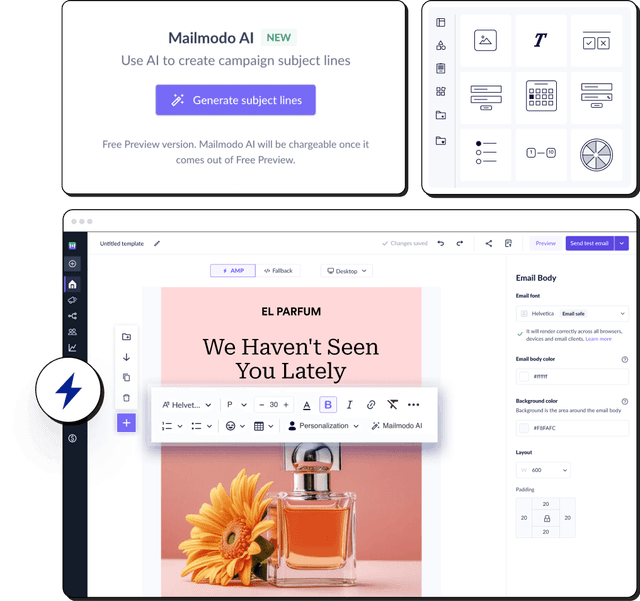What is a marketing qualified lead?
Marketing qualified lead (MQL) is a category of lead amongst the leads generated that your marketing team has deemed to be more likely to convert into a customer. The team qualifies a lead as MQL based on various criteria like the lead's role in their company, the CTAs they clicked, etc.
Here are some of the things that the marketing teams look at when trying to qualify the lead:
Lead magnets they downloaded
Role in the company
Interest or engagement with the marketing campaigns in social media, emails, etc.
CTAs they have clicked, etc.
Pages on your website that they visit
For example, suppose you are an SEO service-providing company. In that case, you are more likely to get sales by targeting the SEO manager of a company rather than the SEO marketing representative. This is because the rep would not have the power to make the purchase decision.
Benefits of defining marketing qualified leads
By now, it's pretty obvious that defining your MQLs is beneficial for your business but let's go more into detail about exactly how it benefits you.
Helps you not waste your time and effort
Identifying marketing qualified leads can help ensure that the marketing team is not wasting time trying to engage people who are not likely to become customers. And it also helps salespeople not waste time on cold leads because when the marketing team hands over MQLs, they are warm leads that are likely to convert.
As discussed, MQLs help sales teams not waste time on cold leads. Apart from saving time and effort, it also helps sales teams create a targeted outreach for the MQLs because they know what the MQL is interested in.
And knowing who MQLs are and what they are interested in helps sales teams work efficiently and ensure that they are only using resources on the leads that can become customers.
Creates a better relationship between sales and marketing teams
Now, because MQLs help both marketing and sales teams save time and effort, it ultimately creates a good relationship between the two teams. Both teams create standard criteria on what makes a lead an MQL or SQL and come to an agreement.
So it eliminates any confusion or misunderstanding between the teams, thereby creating a strong relationship between them. This relationship is key to having a smooth sailing business with lower rejection rates and higher conversion rates.
Helps you improve your content marketing strategy
MQLs don't just help the sales team create a targeted outreach. It also helps content marketers know who they need to target and what type of content they have to create for the MQLs based on their interests.
For example, if someone responds to or interacts with the educational email campaigns we send, they are interested in the information Mailmodo offers. So, we will label them as MQLs and send them more knowledge-based emails to warm them up rather than promotional emails where we prompt users to sign up on Mailmodo.
And, when they create such targeted content to nurture leads, they are more likely to go down the marketing funnel and become customers or even SQLs.
Also read: How to Nurture Leads with Email Marketing?
Helps you understand the success of your marketing strategy
By defining your marketing qualified lead, you will also know how many quality leads you can generate. And if you are not able to get quality leads, you'll know that you'll have to change your marketing strategy to target better quality leads. The number of leads you generate might be less, but they will all be potential buyers.
Marketing qualified lead vs sales qualified lead
You have heard two terms so far, marketing qualified lead (MQL) and sales qualified lead (SQL). And you might wonder if they are the same thing, if not, how they are different from each other.
To put it simply, a lead is first marked as an MQL by the marketing team based on the lead's actions. Then, if the MQL responds well to the marketing efforts and has shown more interest in the company's product or service, the marketing team hands them over to the sales team.
If the sales team agrees with the marketing team that the MQL has good potential to become a customer, then the MQL will be converted into an SQL. After which, the sales team will pursue the SQL through 1:1 discussions or demos rather than the marketing team.

Related guide: A Beginner's Guide to Lead Generation For Generating High-Quality Leads
4 steps to define marketing qualified leads
Yes, okay, we now know what it is, why it's important, and stuff, but how do we define these MQLs? Here are the aspects you need to execute to define your MQLs.
1. Work on the relationship between the marketing and sales team
As we have seen, MQL involves both marketing and sales teams. The marketing team cannot identify high-quality leads without input from the sales team. And the sales team cannot have access to high-quality MQLs without the marketing team's help.
So, before defining MQLs, you need first to bring marketing and sales teams together. Make meetings where both teams discuss, provide feedback, areas for potential growth, etc.
For example, the sales team can tell the marketing team which marketing content works best among potential clients or which content they feel is missing.
Once you have created this relationship, you can move on to the next step: lay down the criteria and characteristics a person must have to be labeled as an MQL.
2. Establish what an MQL looks like for your company
To determine who your MQLs would be, you need to collaborate with both sales and marketing to your ideal customer profile (ICP) and target market. Creating criteria for MQL would be like creating your buyer persona.
Ensure both teams work together to identify the main characteristics or traits so that marketers can identify potential leads that are more likely to convert.
You can ask some of the following questions to determine your MQLs:
What demographic or firmographic traits must a person have to be an MQL?
What type of content should your lead engage with to establish interest and be an MQL? For example, web pages they visit, lead magnet downloads, CTA clicks, interactions with social posts, etc.
What are some pain points or challenges that your potential MQL faces that you can resolve?
Creating such a clear definition of marketing qualified leads helps sales representatives be confident that the MQLs provided by the marketing team are likely to result in conversions.
3. Create a way to score your leads
Now that you have created a lead definition, you can stop here and go on with labeling your leads. Or you can go one point further and create a lead scoring system by assigning point values for various MQL qualifications.
Lead scoring is a method to measure the quality of leads and show their potential value to the business. This will help quantify the quality of the leads rather than work off a vague idea.
Now lead scoring can be a huge concept so let's look at a simple explanation.
Firstly you will assign certain points to certain tasks your leads might perform. Tasks can be anything like interacting with the website, social media, etc.
Next, you'll calculate how many points a certain lead has got.
And now, if the value exceeds the threshold you have set, you can classify them as an MQL.
The scores can help you define a lead better and see if they are ready for a sales discussion or if you have to keep nurturing them.
4. Revise your lead definitions regularly.
The steps mentioned above are not a one-and-done process but rather something you will have to revisit and redefine. This is necessary because as your business grows, increasing the size of your customer base, internal team, etc., your leads, prospects, buyer personas, etc., will also evolve.
So it's important to revise your definition of a lead and update your tactics. You can work with the sales team to redefine your MQLs and set the new scores. The sales team will also provide input based on the type of leads they can convert, and you can revise to target those types of leads.
Define your MQLs today
Now that you understand how integral it is to define your MQLs, all that's left to do is start defining your MQLs today. So, sit down with both your marketing and sales teams to discuss what your MQLs would look like.
There is another scenario where you bring together various marketing teams to create a better marketing strategy that remains cohesive across platforms to increase conversions. That is called integrated marketing. Check out our article on integrated marketing to find out how you can use it to have a cohesive message across all platforms.
What you should do next
Hey there, thanks for reading till the end. Here are 3 ways we can help you grow your business:
Talk to an email expert. Need someone to take your email marketing to the next level? Mailmodo’s experts are here for you. Schedule a 30-minute email consultation. Don’t worry, it’s on the house. Book a meet here.
Send emails that bring higher conversions. Mailmodo is an ESP that helps you to create and send app-like interactive emails with forms, carts, calendars, games, and other widgets for higher conversions. Get started for free.
Get smarter with our email resources. Explore all our knowledge base here and learn about email marketing, marketing strategies, best practices, growth hacks, case studies, templates, and more. Access guides here.










